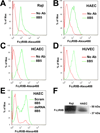Fcγ receptors and ligands and cardiovascular disease
- PMID: 25593280
- PMCID: PMC4331353
- DOI: 10.1161/CIRCRESAHA.116.302795
Fcγ receptors and ligands and cardiovascular disease
Abstract
Fcγ receptors (FcγRs) classically modulate intracellular signaling on binding of the Fc region of IgG in immune response cells. How FcγR and their ligands affect cardiovascular health and disease has been interrogated recently in both preclinical and clinical studies. The stimulation of activating FcγR in endothelial cells, vascular smooth muscle cells, and monocytes/macrophages causes a variety of cellular responses that may contribute to vascular disease pathogenesis. Stimulation of the lone inhibitory FγcR, FcγRIIB, also has adverse consequences in endothelial cells, antagonizing NO production and reparative mechanisms. In preclinical disease models, activating FcγRs promote atherosclerosis, whereas FcγRIIB is protective, and activating FcγRs also enhance thrombotic and nonthrombotic vascular occlusion. The FcγR ligand C-reactive protein (CRP) has undergone intense study. Although in rodents CRP does not affect atherosclerosis, it causes hypertension and insulin resistance and worsens myocardial infarction. Massive data have accumulated indicating an association between increases in circulating CRP and coronary heart disease in humans. However, Mendelian randomization studies reveal that CRP is not likely a disease mediator. CRP genetics and hypertension warrant further investigation. To date, studies of genetic variants of activating FcγRs are insufficient to implicate the receptors in coronary heart disease pathogenesis in humans. However, a link between FcγRIIB and human hypertension may be emerging. Further knowledge of the vascular biology of FcγR and their ligands will potentially enhance our understanding of cardiovascular disorders, particularly in patients whose greater predisposition for disease is not explained by traditional risk factors, such as individuals with autoimmune disorders.
Keywords: C-reactive protein; atherosclerosis; hypertension; nitric oxide synthase type III.
© 2015 American Heart Association, Inc.
Conflict of interest statement
None.
Figures



References
-
- Ravetch JV, Bolland S. IgG Fc receptors. Annu Rev Immunol. 2001;19:275–290. - PubMed
-
- Nimmerjahn F, Ravetch JV. Fcgamma receptors as regulators of immune responses. Nat Rev Immunol. 2008;8:34–47. - PubMed
-
- Nimmerjahn F, Ravetch JV. Fcgamma receptors: old friends and new family members. Immunity. 2006;24:19–28. - PubMed
-
- Ravetch JV, Kinet JP. Fc receptors. Annu Rev Immunol. 1991;9:457–492. - PubMed
-
- van de Winkel JG, Anderson CL. Biology of human immunoglobulin G Fc receptors. J Leukoc Biol. 1991;49:511–524. - PubMed
Publication types
MeSH terms
Substances
Grants and funding
LinkOut - more resources
Full Text Sources
Other Literature Sources
Research Materials
Miscellaneous

